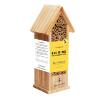Plastikosmd
Member
- Joined
- Oct 16, 2011
- Messages
- 828
I use a racket ball racket and swat them to the ground then step on. However, I find carpenter bee traps to be much more effective as they work all day long and I can't really stand around waiting for them little buggers to come close enough to me to swat...
When it starts to get dark watch to see where they go. I had an overturned wheelbarrow bucket under the deck and saw them flying under it. There was a huge Carpenter Bee nest under it. I used just about a whole can of foaming bug spray to get them.
Carpenter bees do not make big nests, if there was more than one, you found a bumble bee or ground hornet nest.I use a racket ball racket and swat them to the ground then step on. However, I find carpenter bee traps to be much more effective as they work all day long and I can't really stand around waiting for them little buggers to come close enough to me to swat...
When it starts to get dark watch to see where they go. I had an overturned wheelbarrow bucket under the deck and saw them flying under it. There was a huge Carpenter Bee nest under it. I used just about a whole can of foaming bug spray to get them.
I too was under the impression that carpenter bees were more or less solitary in nature.
Carpenter bees do not make big nests, if there was more than one, you found a bumble bee or ground hornet nest.
I know very well what ground hornets and bumble bees look like. Bumble bees only slightly resemble Carpenter bees and Ground Hornets look nothing like Carpenter bees (in northern NY anyway). These were Carpenter bees. As I mentioned, I would watch them scout the eaves and fascia of my house and return to the " WHEELBARROW " bucket for the night. Bumble bees, nor ground hornets chew holes into my eaves/fascia.
When I find an active hole with sawdust dropping from it (indicating the bee is actively at work in it) I apply Sevin with a infant nasal cavity suction bulb (with Sevin in it) with a (chain saw fuel line attached) hose into the hole. The bee usually tries to escape and makes quite a racket. I then withdraw hose and quickly fill hole with plastic wood.
I've been doing battle with these guys for years. They do not chew the coating on my log home but do search out places and small crevices where there is none. Mostly the underside junction of the fascia and eaves...
I hung my traps out yesterday and have caught 3 so far...
Yeah, but that's like using an mortar to kill moles in the yard!also an enjoyable use of the 410

